Contents
- What do mushrooms look like blue footed mushrooms
- Where does the purple-legged row grow
- When to collect lilac-legged rows
- Edible or not lilac-legged row
- Taste qualities of the lilac-footed mushroom
- Benefits and harms to the body of blue-legged mushrooms
- False twins of the mushroom rowing blue leg
- Rules for collecting mushrooms rows of bluelegs
- How to cook a lilac-legged row
- Conclusion
Lilac-footed rowweed is a mushroom that can be eaten after pre-treatment. His appearance is rather unusual, but it is still possible to confuse him with twins, so the features must be carefully studied.
What do mushrooms look like blue footed mushrooms
From the photo and description of the lilac-legged row, or blue-legged, it is obvious that the easiest way to recognize it is by its leg – grayish-purple or bluish. In height, it stretches up to 10 cm, in girth it reaches 3 cm. In young fruiting bodies on the legs, you can see the remnants of a bedspread, similar to uneven flakes, but as they grow older, the surface of the leg is smoothed out.
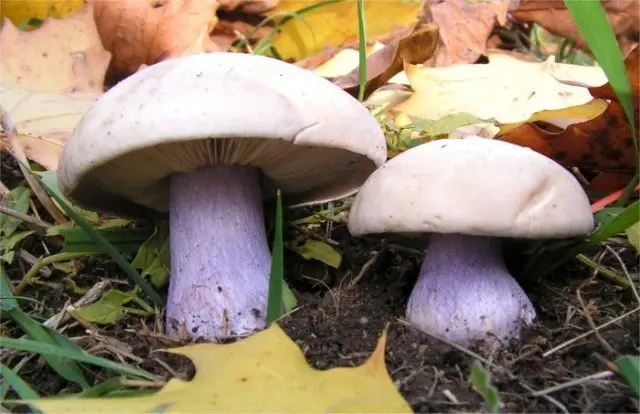
The hat is flattened with a slight bulge, cushion-shaped, on average up to 15 cm in diameter. In the upper part, the cap is smooth to the touch, and from below it is covered with thin wide plates of yellowish or cream color. The color of the hat itself is usually yellowish with a slight purple tint, on the cut it is gray-violet, gray or gray-brown. The fruit body has a dense pulp with a fruity aroma.
Where does the purple-legged row grow
Sinenozhka chooses mainly southern regions for growth, but sometimes it can also be found in central Our Country. Most often, purple-legged rowing grows in pasture meadows and forest clearings, on fertile soils near farms or near compost pits. In the forest zone, you can find it less often.

When to collect lilac-legged rows
The blueleg bears fruit throughout the warm period. For the first time it can be found already in April, and the lilac-legged row continues to grow until mid-October. Therefore, you can collect it throughout the summer, it is best to go in search of it after rainy days, since during this period the fruiting bodies begin to grow most actively.
Edible or not lilac-legged row
Despite the unusual appearance of the blueleg, it is allowed to eat it. However, the lilac-legged row belongs to the conditionally edible category, in other words, it requires careful processing before cooking.
Taste qualities of the lilac-footed mushroom
Blue-footedness belongs to only 4 food categories and is inferior to many other mushrooms. However, experienced mushroom pickers claim that her taste is very pleasant in any form – fried, boiled or pickled. Some compare the taste of bluelegs with the taste of champignons.
An additional advantage can be considered that the lilac-legged rowing retains its shape and elasticity well during processing, it is pleasant to eat it, it does not fall apart and does not loosen.

Benefits and harms to the body of blue-legged mushrooms
The blue row mushroom has a very rich chemical composition. Its pulp contains:
- vitamins A, C, B and D;
- important minerals – manganese and potassium, phosphorus and iron, zinc and phosphorus;
- amino acids – mainly lysine, alanine and threoniline;
- glutamic and stearic acids;
- protein;
- trehalazole;
- natural antibiotics – fomecin and clitocin;
- polysaccharides.
Thanks to this composition, the lilac-legged rowing has a pronounced benefit for the body, namely:
- saturates the body with all the necessary trace elements and vitamins;
- improves metabolism and strengthens the immune system;
- increases endurance due to the high amount of protein in the pulp;
- has a rejuvenating and anti-inflammatory effect;
- has a proven anti-cancer effect – clitocin and fomecin have a depressing effect on cancer cells.
Of course, with all the benefits, one should not forget about the harmful properties of the edible lilac-legged row. It is not recommended to use it:
- with chronic bowel diseases;
- in pancreatitis;
- with sluggish digestion and a tendency to constipation.
Since the blue foot is a rather difficult protein food to digest, it is important to observe moderate dosages of the product. It is necessary to ensure that it is completely fresh and properly prepared, otherwise poisoning with abdominal pain, vomiting and diarrhea may develop.
False twins of the mushroom rowing blue leg
Although the purple-footed row has very characteristic external features, it can still be confused with other mushrooms. Twins exist both edible and inedible, so it is important to be able to distinguish them from each other in the conditions of the autumn forest.
purple row
The two varieties belong to the same genus and are therefore very similar in size, cap and stem structure. However, the purple-footed blueleg has a purple tint only on the stem, while the purple row is distinguished by a uniform purple color. Like the lilac-legged row itself, its double also belongs to the conditionally edible category.
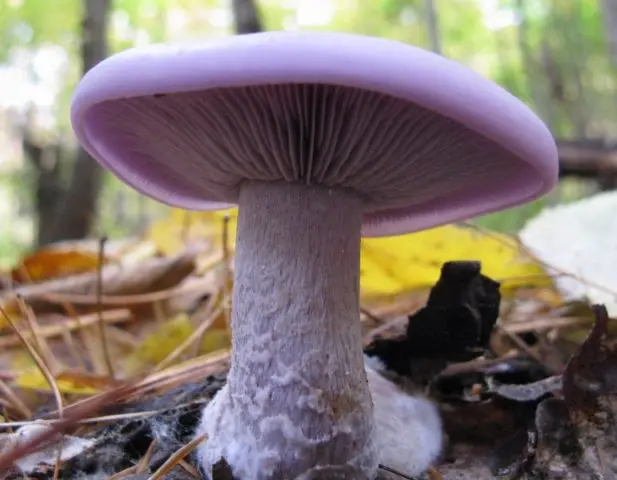
weed row
The lilac-legged rowing is very similar to another mushroom from the genus Lepista. But the weed, or dirty, row has a couple of important differences – the entire fruiting body is completely painted in purple, and the dirty row is much smaller in size than the blue leg.
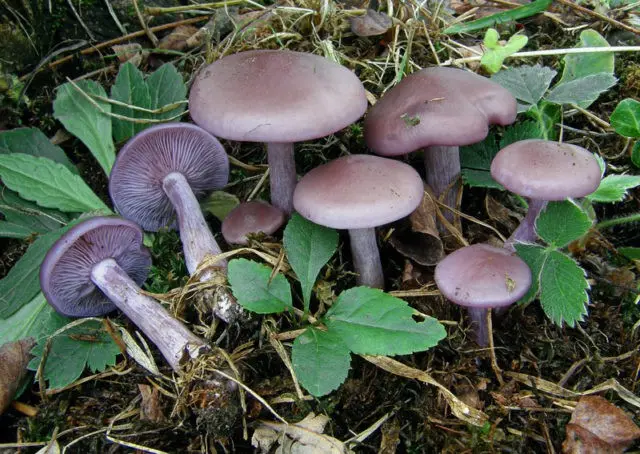
Lilac varnish
The lacquer slightly resembles a blue foot in shape and color, but it is rather difficult to confuse mushrooms with each other. The lilac lacquer is much smaller in size, the diameter of its cap on average reaches only 5 cm. The shade of the cap is dark purple, but the leg is light, whitish.
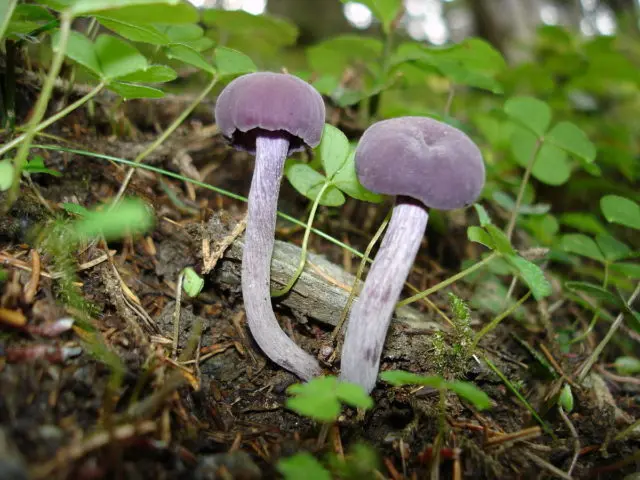
The lilac-legged row differs from the lilac lacquer in that the latter can often be seen not in open space, but in dense forests. You can eat it, but only after processing.
Purple cobweb
This edible mushroom has a bright purple color of the stem and cap; at a young age, it is very similar to the blueleg in structure. You can distinguish varieties from each other by color – in the cobweb it is uniform for the entire fruiting body, in addition, there are remains of a bedspread on the leg, and adult rows have a smooth leg.
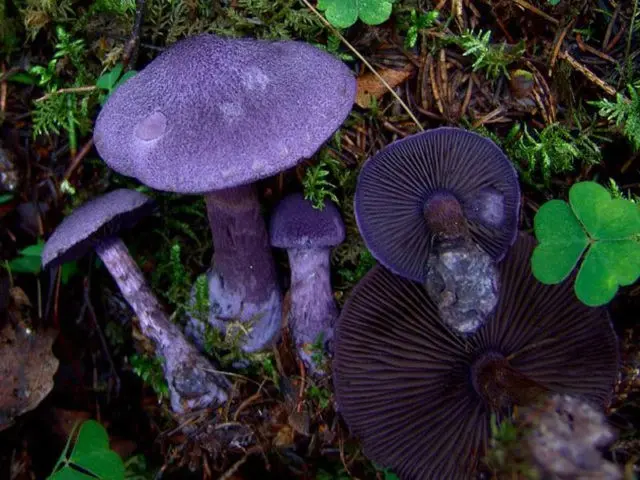
White-purple cobweb
An inedible cobweb and a harmless lilac-legged row are similar to each other in a flat-convex shape and a pale shade of a hat. But the leg of the cobweb is usually lighter than that of the row, and the flesh on the cut is soft and loose. The main distinguishing feature of an inedible cobweb is the presence of a distinct moldy smell.
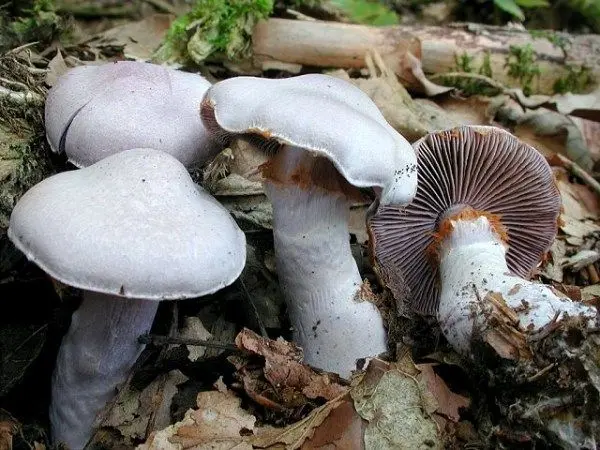
goat web
This mushroom can be confused with the blueleg due to its similar coloration. But the lilac-legged row has a darker leg than the hat, but the goat web usually has a hat with a purple tint and a lighter leg. The mushroom belongs to the category of inedible and smells unpleasant, according to mushroom pickers, its aroma is most reminiscent of acetylene.

pure mycena
The hallucinogenic inedible mycena has a flattened cap with a central tubercle, and its cap and stem are tinted purple. But the leg of the mycena is lighter than the cap, and most importantly, the miniature size is characteristic of the mycena. If it can rise 8 cm above the ground, then the diameter of the hat most often does not exceed 5 cm.
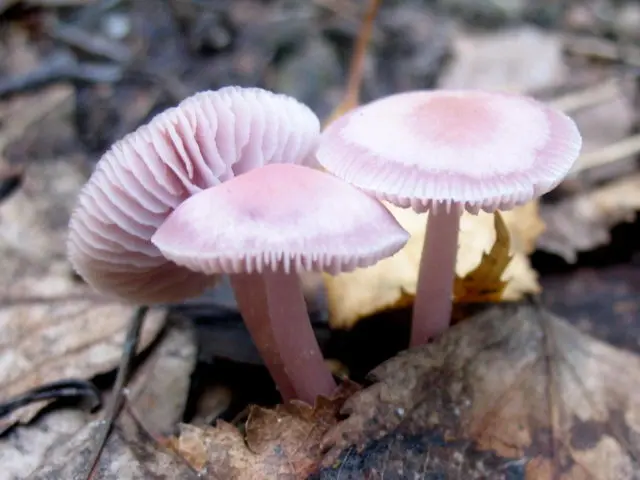
Rules for collecting mushrooms rows of bluelegs
The main fruiting of the blueleg occurs in the summer, although it can be found in the forest already in the middle of spring, and it disappears closer to the first frost. It is best to go to the collection at the end of summer, when the lilac-legged row is growing especially actively.
You should look for the blue foot in open places – in glades, meadows and pastures. In the forest, she also comes across, but much less often. The biggest harvest can be collected if you go to the field after heavy rains.
Since the purple-legged row is a conditionally edible mushroom with many doubles, it is necessary to carefully study the find before putting it in the basket. It is forbidden to eat raw mushroom caps – this is fraught with food poisoning, even if the type of mushroom is determined correctly.
How to cook a lilac-legged row
Before eating a natural product, it must be carefully processed:
- First of all, the lilac-legged row is cut off, the plates with spores are removed from it, that is, the lower part of the cap. In any case, the plates are not digested by the body and can cause poisoning.
- You also need to cut off the legs, they are usually not eaten, so you can remove the legs not only at home, but also in the field, at the collection stage. In addition, in this case, more will fit in the basket of mushrooms.
- Before cooking, the mushroom is properly soaked in cold salted water for at least 40 minutes.
- After that, the row is washed twice under running water and boiled for about half an hour.
- When boiling, it is recommended to add a little citric acid – this allows you to save the unusual color of the mushroom and its aroma.
Processed blueleg can be prepared in any basic way – recipes for purple-legged rowing suggest frying, pickling and salting a delicious mushroom. Properly cooked blueleg goes well with vegetables and soups, meat dishes and potatoes, spaghetti.

Conclusion
Purple-legged rowing is a tasty and rather healthy mushroom with a bright and recognizable color. To harvest a good crop of bluelegs, you need to properly study its appearance and features, as well as look at photos of false twins.









